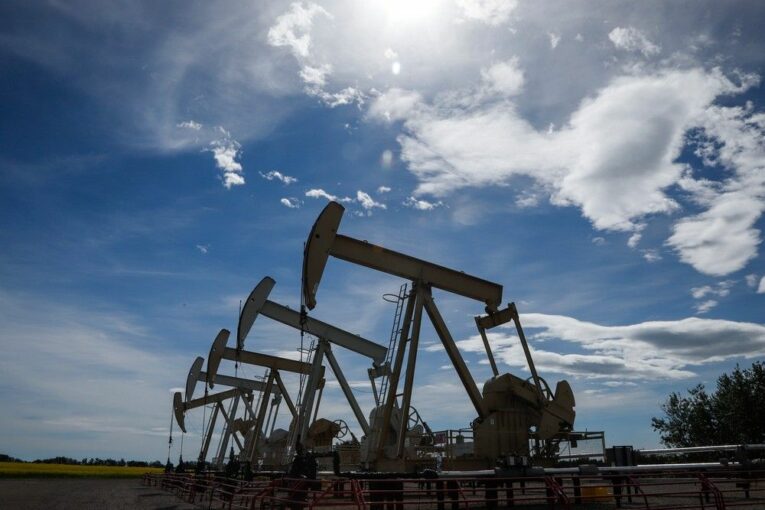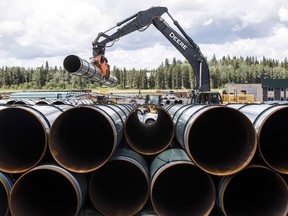
[ad_1]
How do you become bulletproof?
As oil prices jumped above US$80 a barrel this week, many Canadian petroleum producers are searching for that answer by continuing to rapidly pay down debt with an eye to pushing it to microscopic levels — even becoming debt-free in 2023.
“We literally have a bulletproof balance sheet now,” NuVista Energy CEO Jonathan Wright said Tuesday, speaking on the sidelines of the BMO Capital Markets CAPP Energy Symposium in Toronto.
“We’ve paid down almost half a billion dollars of debt now since the pandemic, because the pandemic-pricing scenario was worse than anything we ever expected as an industry . . . We don’t ever want to enter such a thing again with debt.”
A similar refrain is heard in various corners of the industry as the outlook for oil prices improves and profits remain high, but volatility continues to rattle global energy markets.
On Tuesday, prices for West Texas Intermediate crude closed at US$80.71 a barrel in the aftermath of an unexpected production cut announced by OPEC+ countries on the weekend.
Analysts anticipate crude prices could be headed even higher later this year, while prices for benchmark U.S. natural gas continue to languish, closing at $2.11 per million British thermal units.
Last year, exceptional prices for both commodities allowed NuVista, a growing junior petroleum producer, to chop its net debt levels by 64 per cent to $172 million.
“The industry in general, both gas and oil, has never (been) healthier. I mean, we’ve all paid down debt levels and we’ve got serious discipline, and cushion, in just about every direction,” said Wright.
“We are close enough to zero that we may get to zero (debt) . . . We’re so low, it’s kind of an irrelevant level right now.”
A report by BMO Capital Markets in January estimated that with petroleum producers enjoying strong cash flow levels last year, companies were expected to deleverage by $19 billion.
Commodity prices have moderated this year, but Canadian oil and gas revenues are expected to reach $190 billion this year, the second-highest figure in the past decade, according to ARC Energy Research Institute.
Meanwhile, total industry capital spending remains well below cash flow levels. It gives producers ample ability to return money to investors through share buybacks and dividends, while also repaying debt to strengthen their balance sheets.
Producers in the Canadian sector are near “the strongest that we have ever seen them,” said Brad Wells, head of energy at BMO Capital Markets.
Paying down debt “can also be a prudent decision when you think about some of the volatility and the uncertainty that we’ve seen in the commodity price backdrop,” he said.
“A lot of these balance sheets are bulletproof, which is a comfortable place to be in.”

Mid-sized producer Enerplus Corp. lowered its net debt levels by 65 per cent last year to US$222 million.
Enerplus CEO Ian Dundas said such a strategy provides companies with more stability and resiliency to withstand sudden shifts in oil and gas prices.
“It sort of begs the question, what’s next? If oil stays where it is now, our plans would have us debt-free this year, which we never imagined,” he said.
“For our company, we don’t have a goal of being debt free. You know, I’ll open a bottle of wine if we get there, but it’s not a specific goal . . . Everyone’s going to be in a place where they’re going to have the opportunity to be debt free. And then the next step from there is actually building cash.”
That would mark quite a change for the industry.
Analyst Jeremy McCrea with Raymond James noted that in the past three years, lending by Canadian banks to oil and gas firms has plunged 54 per cent to $27 billion as companies haven’t needed to borrow more during a period of strong commodity prices.
Producers have enough cash to hike their capital expenditures, increase returns to investors and pay off more debt, which he called “the default option.”
Recommended from Editorial
-

Varcoe: Canadian producers ponder return of $100 oil after OPEC+ output cut
-

Varcoe: Canadian producers ponder return of $100 oil after OPEC+ output cut ‘With this cut, it almost just locks it in, that we’ll get $100 a barrel in the back half of the year’ 10 Comments Chris Varcoe 23 hours ago Columnists FILE PHOTO: Surge Energy CEO Paul Colborne was photographed in the company’s Calgary offices on Wednesday, Oct. 23, 2013. Energy sector notches its best day since October on OPEC+ cut
It also gives companies the ability to jump on potential acquisition opportunities.
Last year, Crescent Point Energy Corp. cut its net debt by more than 40 per cent, or $850 million. It positioned the Calgary-based producer to buy assets last week in the Montney formation from Spartan Delta Corp. for $1.7 billion in cash.
CEO Craig Bryksa said the company’s absolute debt level is expected to sit around $2.6 billion by year’s end, although Crescent Point is looking to sell non-core assets and pay it down faster over the next 12 months.
“When you look at the sector now as a whole, balance sheets have never been in a stronger position, companies are even driving toward zero net debt. And what you’re seeing is a strategic shift from the sector,” said Bryksa, who is also the chair of CAPP.
“We strengthened our balance sheet so that we had the ability to self-fund a deal to help the long-term sustainability of the company. And now, we’re going to get back on a cycle of paying down our debt again.”
Chris Varcoe is a Calgary Herald columnist.
[ad_2]
You can read more of the news on source
